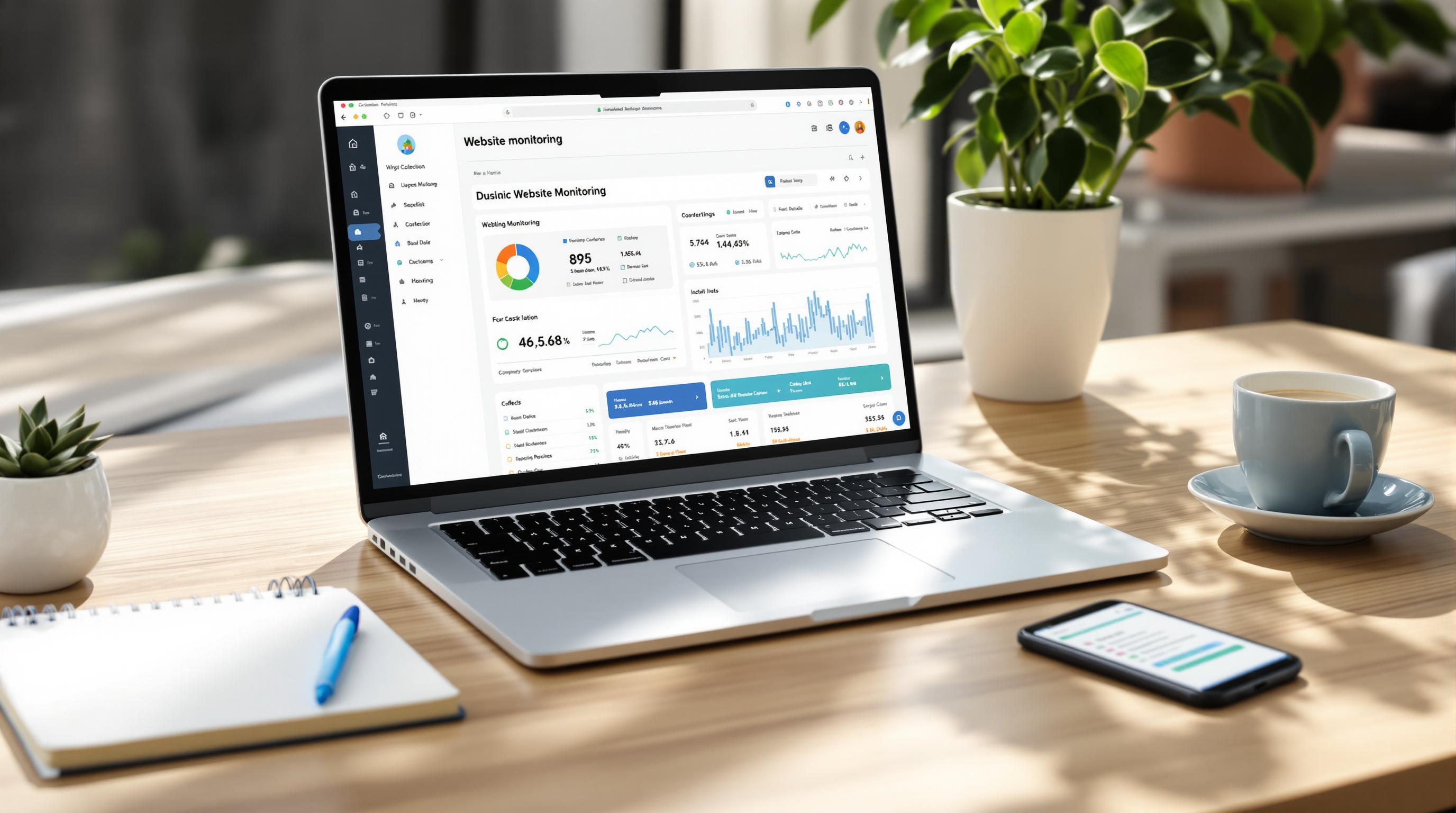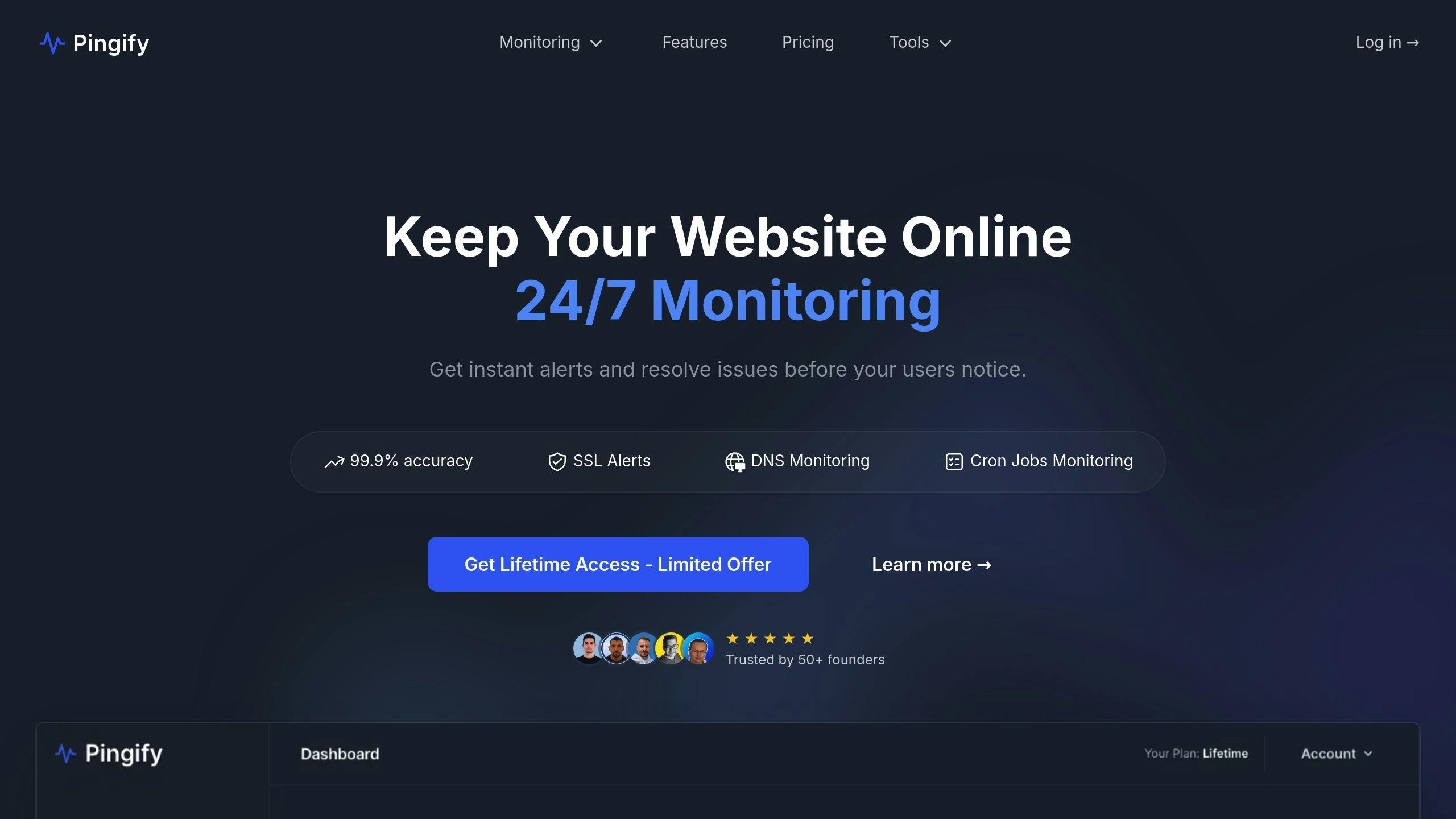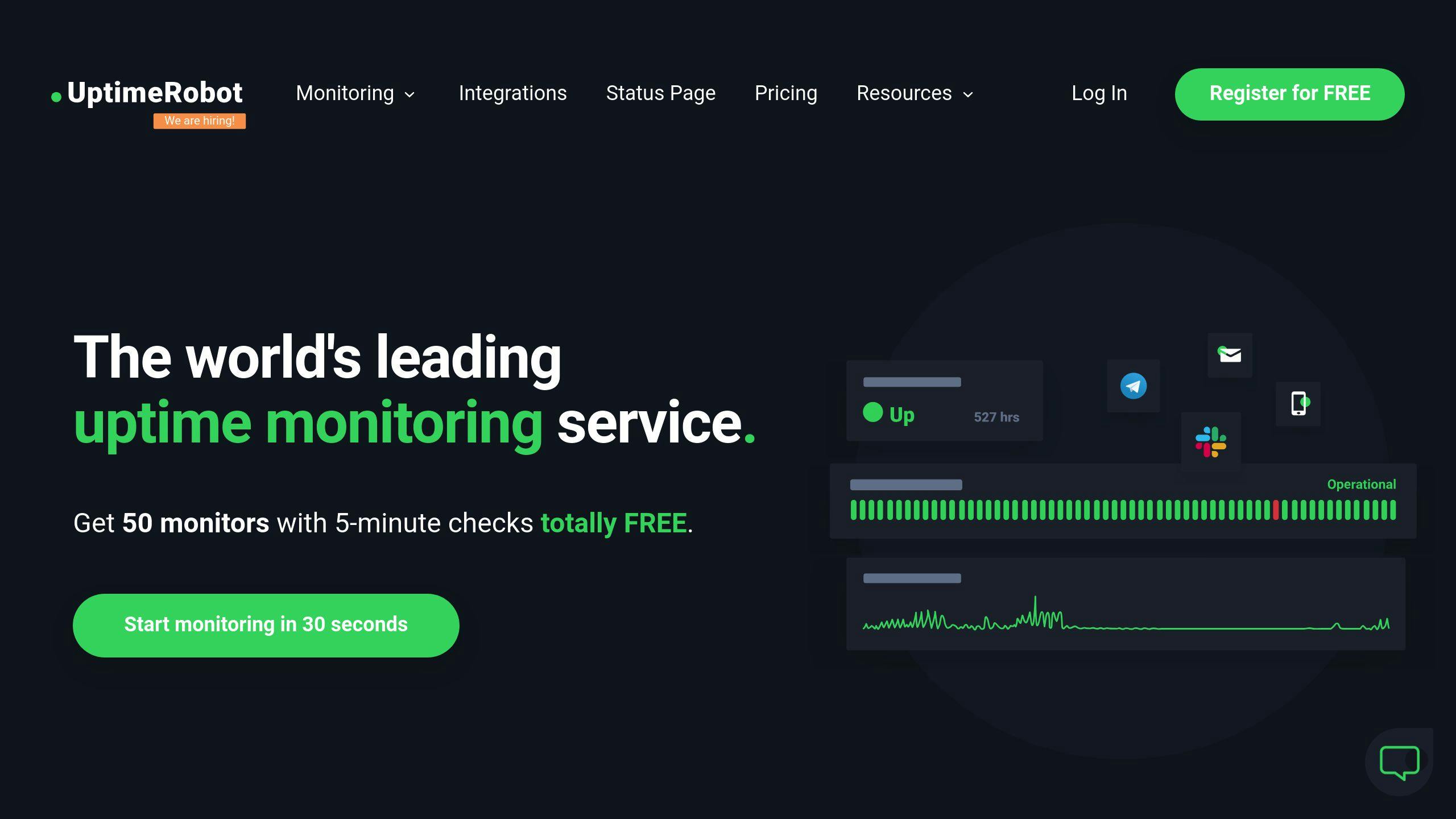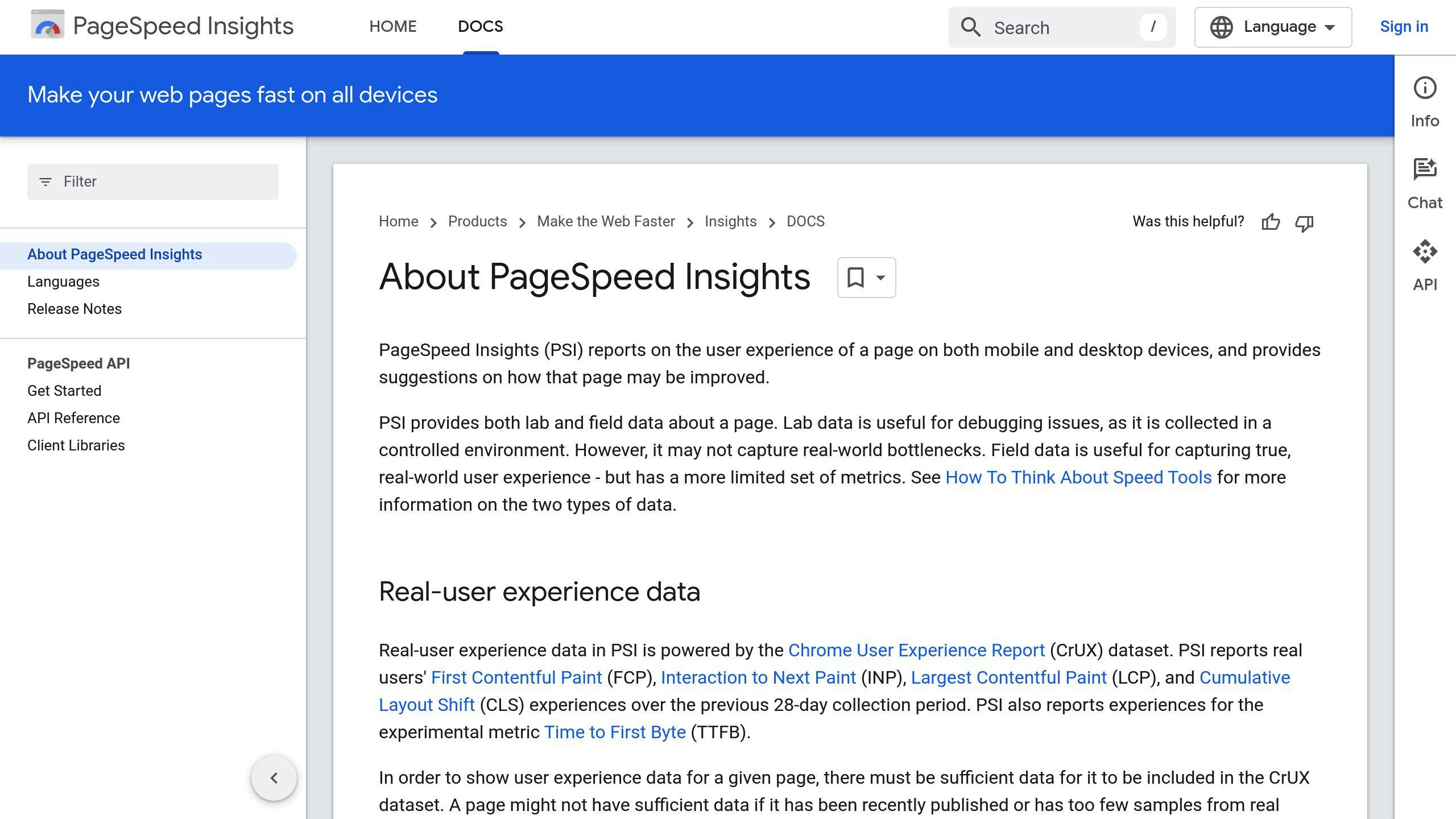Website Monitoring Checklist for Small Businesses

Website Monitoring Checklist for Small Businesses
Your website is vital to your small business's success. Monitoring it ensures it stays online, secure, and fast, protecting your revenue and reputation. Here’s a quick checklist of what you need to monitor and why:
- Uptime: Stay online with tools like UptimeRobot or Pingify, which send real-time alerts for downtime.
- Performance: Keep load times under 3 seconds to boost user experience and conversions.
- Security: Regularly check for malware, SSL certificate issues, and DNS errors to safeguard customer data.
- SSL & DNS: Monitor SSL expirations and DNS records to avoid accessibility and trust issues.
- Cron Jobs: Ensure automated tasks like backups and updates run smoothly.
- Tools: Use tools like Pingify, UptimeRobot, and Google PageSpeed Insights to simplify monitoring.
Quick Tip: Combine tools and set up real-time alerts across multiple channels (email, SMS, Slack) to address issues immediately.
What is Website Monitoring? | Website Monitoring 101
1. Uptime Monitoring: Keeping Your Website Online
Downtime can hurt small businesses by reducing revenue and damaging customer trust. Uptime monitoring helps you avoid these problems by ensuring your website stays accessible.
Use Real-Time Monitoring Tools
Real-time monitoring tools keep a constant watch on your website's availability. Here are a few popular options:
| Tool | Free Plan Features | Starting Price |
|---|---|---|
| UptimeRobot | 50 monitors, 5-min intervals | $15/month |
| Pingify | Basic monitoring | Custom pricing |
| StatusCake | Basic uptime checks | Contact sales |
These tools send real-time alerts and provide public status pages to keep your team informed. To enhance coverage, set up monitoring from multiple locations and use various notification channels.
Set Monitoring Intervals
Choose monitoring intervals between 1 and 5 minutes depending on your website's purpose. E-commerce sites usually need shorter intervals, while informational sites can afford longer ones. Keep in mind the balance between monitoring frequency, server load, and your budget.
To get the best results, configure checks from multiple locations. This helps identify whether an issue is specific to a local network or a broader website problem.
Pro tip: Start with 5-minute intervals and adjust based on your site's performance history and business needs.
Uptime monitoring keeps your site running smoothly, and real-time alerts help you respond quickly when issues occur.
2. Real-Time Alerts: Getting Notified of Website Issues
Fast action can make all the difference when it comes to avoiding lost customers or revenue. Real-time alerts build on uptime monitoring by ensuring you're instantly aware of any issues, so they can be resolved quickly.
Setting Up Effective Alerts
To stay on top of problems, it's important to use multiple notification channels and tailor alerts to fit your business needs:
| Notification Channel | Best Used For | Key Benefit |
|---|---|---|
| Detailed reports | Provides in-depth updates | |
| SMS | Urgent issues | Works without internet |
| Slack | Team coordination | Simplifies team responses |
| Telegram | Mobile notifications | Ensures reliable delivery |
| Automated integrations | Tool connectivity | Makes workflows smoother |
Pro tip: Use at least three notification channels. This avoids overwhelming your team while ensuring critical alerts always get through.
Key alerts to configure include:
- Downtime
- Performance problems
- SSL certificate expirations
- DNS changes
- Cron job failures
You can also categorize alerts by severity to decide how quickly they need to be addressed:
| Severity Level | Response Time | Example Triggers |
|---|---|---|
| Critical | Immediate (24/7) | Complete site outage, SSL failure |
| High | Within 1 hour | Major performance drop |
| Medium | Within 4 hours | Minor functionality issues |
| Low | Next business day | Routine updates or non-urgent fixes |
Regularly review and tweak your alert settings based on how your website performs and your business needs.
"The key to effective website monitoring isn't just collecting data – it's ensuring the right information reaches the right people at the right time through the right channels" [1].
With real-time alerts sorted, the next focus should be on maintaining your website's security and accessibility through SSL and DNS monitoring.
3. SSL and DNS Monitoring: Keeping Your Website Secure and Accessible
SSL certificates and DNS settings are essential for website security and smooth operation. Issues in these areas can lead to downtime or security risks, potentially damaging your business and user trust. Regular monitoring helps avoid such problems and ensures your website remains reliable.
Keep an Eye on SSL Certificates
SSL certificate monitoring involves two main tasks:
| What to Monitor | What to Check | Why It’s Important |
|---|---|---|
| Certificate Validity | Expiration dates, encryption level | Avoids browser warnings and keeps user trust intact |
| Validation Records | CNAME or TXT records | Ensures certificates are verified and functioning |
Here’s how to stay on top of SSL certificates:
- Use tools like Pingify to automate daily SSL checks and get renewal alerts before certificates expire.
- Double-check that your provider's validation records (like CNAME or TXT) are properly set up.
Stay on Top of DNS Records
DNS monitoring ensures your website remains accessible. Pay attention to the following:
| DNS Record Type | Purpose | What Happens If Misconfigured |
|---|---|---|
| A Records | Maps domain to IP address | Users can’t access your website |
| MX Records | Handles email routing | Email communication fails |
| TXT Records | Security verification | SSL-related issues arise |
To keep DNS settings error-free, automated tools like Pingify can track changes and maintain logs of approved modifications, helping to prevent mistakes.
"The key to effective SSL and DNS monitoring isn't just implementing the tools – it's establishing a systematic approach to verification and response that prevents security gaps and accessibility issues" [2].
Quick tip: Choose tools that combine SSL and DNS monitoring to streamline your workflow and cut down on costs.
Once your SSL and DNS monitoring is in place, you’ll be ready to focus on improving website performance and tackling other security challenges.
4. Performance and Security Monitoring: Improving User Experience
Once your SSL and DNS are properly set up, the next step is making sure your website runs smoothly and stays protected from threats. Small businesses can achieve this using cost-effective, scalable tools.
Key Areas for Monitoring
Performance Metrics
Keep an eye on these key metrics to ensure a smooth experience for your users:
| Metric | Target |
|---|---|
| Page Load Time | Under 3 seconds |
| Time to First Byte | Under 200ms |
| Bounce Rate | Below 40% |
| Session Duration | Over 3 minutes |
Here’s why they matter:
- Fast load times keep visitors on your site and boost conversions.
- Quick server responses improve your search rankings.
- Low bounce rates mean your content is engaging.
- Longer session durations indicate users are finding value on your site.
"A 1-second delay in page load time can result in a 7% reduction in conversions" [3].
Security Monitoring
Protecting your site is just as important as its performance. Follow these practices to stay secure:
- Run daily malware scans.
- Perform weekly vulnerability checks.
- Use real-time access log monitoring.
- Keep all software and plugins updated regularly.
Key steps to strengthen security:
- Set up alerts for unusual activity.
- Use automated security scans for efficiency.
- Test from multiple global locations to catch regional issues.
- Maintain detailed logs of security events for analysis.
Pro tip: Look for tools that combine performance and security monitoring. They save time and simplify your workflow by handling both tasks in one place.
5. Managing Cron Jobs: Automating Website Tasks
Automating tasks can simplify website upkeep. Cron jobs take care of routine operations like database backups, content scheduling, and system maintenance - no manual effort required. For small businesses, keeping cron jobs running smoothly is crucial. Missed backups, outdated content, or server issues can result from poorly managed tasks.
Keep an Eye on Cron Jobs
Here’s what to watch for when monitoring cron jobs:
- Execution status: Ensure tasks run as planned.
- Task duration: Track how long each job takes.
- Resource usage: Monitor daily to avoid overloading systems.
- Success rates: Check weekly for consistency.
Tips for effective monitoring:
- Use tools like Pingify to track task execution.
- Set up real-time alerts to catch failed jobs quickly.
- Track both job completion and duration to spot potential slowdowns.
- Apply timeout limits to prevent long-running tasks from hogging resources.
Regular Reviews Matter
Every few months, review your cron jobs to keep them relevant and efficient:
- Remove unnecessary or outdated tasks.
- Adjust schedules to avoid high-traffic times.
- Check task dependencies to ensure proper sequencing.
- Monitor server resources to avoid overload.
Key management practices:
- Document everything: Keep a record of each task’s purpose, schedule, and dependencies.
- Use monitoring tools: Pingify’s features can help you track success rates and execution times.
- Analyze logs regularly: Look at performance logs to spot recurring issues and fine-tune your schedule.
Pro tip: Tracking both job completion and duration can help you catch performance dips before they become bigger problems.
Once your cron jobs are under control, it’s time to explore tools that can simplify website monitoring even further.
6. Tools for Website Monitoring
Once you've identified the key areas of your website to monitor, the next step is finding tools that can make the process easier and more efficient. Here are three tools that focus on uptime, security, and performance.
Pingify

Pingify is designed for small businesses, offering a simple dashboard that combines several monitoring features.
| Feature | What It Does |
|---|---|
| All-in-one Monitoring | Keep track of uptime, SSL/DNS, and cron jobs in one place |
| Multi-channel Alerts | Receive notifications via email, Slack, Telegram, and webhooks |
| Performance Tracking | Monitor website speed and availability |
Pingify’s one-time $19 plan provides access to essential features, making it a budget-friendly option for smaller businesses.
UptimeRobot

UptimeRobot is a user-friendly tool that offers flexible monitoring options, customizable alert intervals, and the ability to create status pages.
Some of its key features include:
- Status page creation for public-facing updates
- Detailed uptime reports to track performance over time
- Advanced monitoring options for more complex needs
You can start with the free plan, which covers up to 50 websites, or opt for paid plans starting at $14.95/month for additional functionality.
Google PageSpeed Insights

Google PageSpeed Insights helps identify performance bottlenecks and provides specific recommendations to improve your website's speed and user experience. This free tool analyzes both mobile and desktop performance, giving you a full picture of your site's responsiveness.
Tip: Run tests monthly to stay on top of performance trends and address potential issues before they escalate.
"Studies have shown that even a few minutes of downtime can significantly impact a business's revenue and reputation. Tools like Pingify and UptimeRobot help mitigate this risk by providing real-time monitoring and alerts, ensuring that issues are addressed quickly." [3]
These tools make it easier for small businesses to maintain a reliable and secure online presence with less hassle.
Conclusion: Maintaining a Reliable and Secure Website
By using the steps in this checklist, small businesses can keep their websites running smoothly, securely, and efficiently. Website monitoring is a must-have for any business looking to maintain a strong online presence.
Every element of this checklist - from keeping an eye on uptime to leveraging automation - works together to create a solid plan for website management. Consistent monitoring helps protect your business's revenue, reputation, and customer trust.
Setting the right monitoring intervals and using multiple notification channels ensures you can address issues quickly. Tools like Pingify, UptimeRobot, and Google PageSpeed Insights take the hassle out of monitoring by automating key tasks, making them especially useful for small businesses.
Effective website monitoring means regularly checking performance metrics, security settings, and automated processes. As your business expands, your monitoring approach should adapt to tackle new challenges. Secure SSL/DNS configurations and routine scans are crucial for safeguarding customer data and avoiding security breaches.
Make it a habit to review your monitoring setup every quarter to stay aligned with your business goals and industry standards. Regular monitoring not only helps you avoid potential problems but also lays the groundwork for sustained growth and happy customers.
FAQs
What is the best website monitoring service or tool?
Picking the right website monitoring tool depends on your specific business needs. Here's a quick breakdown of tools suited for different purposes:
| Monitoring Need | Recommended Tool | Primary Function |
|---|---|---|
| Security | Intruder | Scans for vulnerabilities |
| User Experience | Hotjar | Provides heatmaps and session recordings |
| Performance | Pingdom | Tracks uptime and speed |
| Site Health | Lumar | Analyzes technical SEO and content |
If you're running a small business and just getting started, these tools are worth considering:
- All-in-one solution: Pingify's Essentials plan offers a broad range of monitoring features.
- Basic monitoring: UptimeRobot gives you free uptime tracking.
- Performance analysis: Google PageSpeed Insights is a free tool for testing site performance.
When choosing a tool, focus on these three factors:
- How well it integrates with your current systems.
- Whether it offers customizable alerts.
- Its ability to monitor across various geographic regions.
"Studies have shown that even a few minutes of downtime can significantly impact a business's revenue and reputation. Tools like Pingify and UptimeRobot help mitigate this risk by providing real-time monitoring and alerts, ensuring that issues are addressed quickly." [3]
